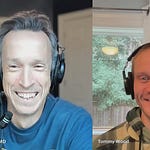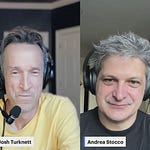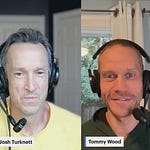A very interesting study came out recently that examines the effect on high intensity interval training on brain health and cognitive function.
If you’d prefer to listen to the podcast, just click below. Or, if you’d prefer to continue reading, then just keep scrolling for the edited transcript of our conversation.
The study we’re talking about today is entitled "Long Term Improvement in Hippocampal Dependent Learning Ability in Healthy Aged Individuals Following High Intensity Interval Training."
It was published in July 2024 in the journal Aging and Disease. And the goal was to determine the impact of high intensity interval training on hippocampal dependent cognitive functions, so cognitive functions that are mediated by the hippocampus. And that's because the hippocampus is a part of the brain known to be impacted early in age-related cognitive decline and Alzheimer's.
As we've talked about, there's already a large body of evidence that shows that exercise is beneficial to cognitive health and this study is kind of exploring more specific details about the kind of exercise, so whether differing kinds of exercise regimens or protocols would have differing impact on the brain.
And we've talked before about research showing that exercise that has a skill or a coordination component like dance or skill sports tends to have greater cognitive benefits. This particular study is looking at the question of whether high intensity interval training may have differing impacts on the brain versus other forms of cardiovascular training.
So is all cardio created equal or are some forms better for certain parts of the brain than others? And in particular for parts of the brain that we know to be impacted early on in Alzheimer's.
The Study Design Included Three Different Exercise Protocols Over Six Months
So in this study, it was a randomized controlled trial over six years in Australia and took subjects who were 65 to 85 in age, healthy with no cognitive impairment.
And 151 subjects completed the study in all. They were randomly assigned to one of three groups. And the groups varied by their exercise protocol that they underwent. And so there was a low, a medium, and a high intensity. And they all performed three sessions per week of their protocol for six months.
So for a total of 72 sessions. And each of the sessions was 40 to 45 minutes in length and was supervised so that they maintained an intensity to achieve the target heart rate for whatever group they were in.
So in the low intensity group, they did things like stretching and balance exercise, range of motion and the target heart rate was 45 to 55 percent of their peak.
The medium intensity did continuous treadmill walking with a target heart rate of 60 to 75%. And then the high intensity interval group did four high intensity intervals on a treadmill for four minutes with their heart rate maintained from 85 to 95 percent with three minutes of rest in between. And then they did various forms of measurement.
They did cognitive testing monthly, and then they continued to do the cognitive testing every six months until five years after they completed the exercise regimen. They also did blood work before the study and after each of the exercise sessions.
And then they did MRI on a subset of the study population at the start, at six months, and 12 months. And their primary outcome was the cognitive testing and other things like blood biomarkers and hippocampal volume were secondary.
High-Intensity Training Improved Memory Performance for Up to Five Years
So the key finding was that the performance of the high intensity interval training group on the PAL test, which is paired associative learning, improved relative to baseline at six months, which is at the conclusion of the training, but also up to the five year mark.
So remember, this is in 65 to 85 year olds. So not only remaining stable, but actually improving their baseline performance even five years later after the initial testing is done. Also of note is that the other groups, even though they didn't improve over the course of the study, were able to maintain their cognitive function from baseline.
And then there were not differences between the groups on the other cognitive testing. So it was specific to the PAL, which I'll talk more about in a sec. There were also the MRI scans looking at white matter, which actually showed equal improvement.
So the PAL test, as I mentioned, was the one that was shown to be significantly different between groups where only the HIIT, the High Intensity Interval Training Group, showed improvements.
And this is considered a hippocampal mediated function. So this is known to be a particular cognitive function mediated by the hippocampus and chosen because of its sensitivity for early Alzheimer's disease. So this particular test is good at detecting early AD and it involves remembering the location of different visual images that are presented on a screen.
And again, imaging studies when you do this show that it engages the hippocampus. So those who did the HIT training three times per week were the ones that showed significant improvements in this particular cognitive task that's known to be impacted in early Alzheimer's and sustained those improvements for five years.
Additionally, the improvements were most pronounced for those who actually started off on the lowest end of cognitive function, similar to the findings from the review paper that we published on resistance training and cognitive function, where again, the benefits were most significant for those who had started out on the lower end of cognitive function.
Blood Tests Revealed Specific Biomarkers Associated with Cognitive Improvement
As I mentioned, they also checked blood biomarkers and imaging. With the biomarkers, they were done before the testing, I mean before the exercise and after each session, and they chose 17 different ones in all, several that were known to be associated with neuroplasticity and neurogenesis, and then others associated with inflammation, and the noteworthy findings there were that growth hormone beta hydroxybutyrate, BDNF, and cortisol all increased after exercise most significantly in the HIT group, but only the BDNF and cortisol increases correlated with the improvements in the PAL test.
So, you know, why might this be? We know that exercise is a short-term stressor, and it's the adaptations to that stress that make us more healthy and resilient in the long term. The fancy word for that being hormesis, and the increase in cortisol after exercise is thought to be a marker of the intensity of that stress response.
So, the greater the response, the greater the adaptations, the greater the benefits, that would kind of explain the connection there between increases in cortisol post exercise, and improvements in PAL function in the brain over time.
Brain Imaging Showed Preservation of Hippocampal Volume in the High-Intensity Group
And then as far as the imaging goes, they found that the high intensity group maintained volume in the hippocampus while in the other groups it declined, which is typical for people in this age bracket. So, you know, volume loss in the brain is most commonly seen with age typically accelerating after midlife and most pronounced in the hippocampus, especially after 65. And yet in this particular cohort that did the HIT, it was arrested.
The Study Demonstrates That Age-Related Brain Changes Are Influenced by Lifestyle
Again, I think another illustration that what we refer to as aging, in this case, volume loss in the brain along with cognitive decline in late life, is still entirely contingent on lifestyle and environment.
The Practical Application Involves Regular High-Intensity Exercise Sessions
So, if you're listening, you may be wondering what would be the key practical takeaway from this study. The main thing to say is that regular high intensity exercise has significant benefits for an area of the brain that's prominently involved in Alzheimer's.
We know, again, that exercise in general is beneficial, but it comes in many different forms, and those different forms appear to have differing benefits. And in this particular case, getting your heart rate up to 85 to 95 percent of its maximum periodically confers special benefits, ones particular to Alzheimer's protection.
And in this particular study again, it was four, four-minute intervals, three times per week. And I think it's likely the type of exercise for this particular indication is less important than maintaining heart rate in that zone. Here, they did it with a treadmill.
And if you're wanting to know how to figure out your target heart rate, 85-95 percent of peak. So your peak is typically 220 minus your age. So if you were 65, that would be 155 would be your peak heart rate. So you calculate 85 percent of that would be around 132, 95 percent would be 147.
So that would be your range that you would be aiming for, something like this. And there are plenty of calculators online that can make this calculation for you. You can also get this sort of thing from a sport. If you have a heart rate monitor, it can be helpful. So anything where it's kind of getting your heart rate regularly into that zone, we would hypothesize that it's likely based on the study to confer similar benefits.
Current Medical Research Prioritizes Drug Development Over Lifestyle Interventions
So I'll talk about why I like this study. So as you've heard us talk about many times over, nothing beats lifestyle interventions for both preventing but also improving cognition and brain health. That's because they're number one, our most powerful and our safest tools.
And that's because these conditions are driven by lifestyle and environment. And the biggest of all, and the one we must utilize, because it derives the demand for tissue growth and repair, is exercise, both cognitive and physical. And in my opinion, we should be devoting almost all of our resources towards getting really smart about how to utilize those interventions, which we've really yet to do.
And I think this study is a great illustration of exactly the kind of research we need to be doing a whole lot more of. Because as it shows, the details really matter, you know, exercise isn't just one tool with one effect, but many different tools with many different effects.
And you can imagine over time, us establishing this broad collection of targeted lifestyle interventions that we customize to specific needs and indications for an individual, just as we now have a broad collection of drugs with specific indications.
And each of those lifestyle interventions is likely to be safer and more effective than the drugs that we currently have. So this could be kind of the pharmacy of the future, but building it would require lots more research like this and a shift in our priorities. Right now our allocation of resources when it comes to research in Alzheimer's and many other areas of medicine is inverted when you consider the potential ROI, almost all towards drug development.
Which has limited potential, very little towards lifestyle intervention, which has enormous potential. So, spending a lot of money on things with small potential return when we could be spending less on things with a very high potential return.
And one of the main reasons, of course, why our resources are allocated that way is because of the incentives - it’s hard to make a lot of money off of a finding like this. You know, if a pharma company published this kind of result for a drug, on the other hand, its valuation would probably go up by a few billion dollars.
So right now, there aren't strong market forces that will promote the kind of research we need which is a big reason why there's been so little progress in medical therapeutics over the past several decades, not just in Alzheimer's.
And also highlights the importance of having funding sources for this kind of stuff which right now is in the form of government grants and non-profits. This particular study was funded by the Stafford Fox Medical Research Foundation, which is a non-profit. And I looked this up and in 2020, 66 percent of medical R and D was from pharma, which amounted to 161 billion.
The next biggest was the federal government at 25%. And of course, virtually none of that 161 billion is going towards lifestyle interventions and that only leaves a small fraction of the rest to be accounted for by academic institutions and non-profit foundations. So if we want continued progress in this area, and really in all of the major diseases of our era which I don't think are going to be solved by pharmaceuticals, it's critical that this kind of funding continues and crucial that a significant portion goes to this kind of research.
And a final point I'll make about the finding here which relates back to our demand model of cognitive decline and dementia that Tommy and I have put forth, I think it's natural to say that the takeaway from this study is that high intensity interval training is good for the brain, but you could just as well frame it as saying that an absence of high intensity interval training is bad for the brain.
And our most familiar form of high intensity training is sprinting, which is something we do all the time as kids. And less and less of as we get older. And again, that reframes aging as not some inevitable process of tissue decline over time, but rather our body's response to what are now the typical changes in lifestyle that occur over our lifespan.
So, I find it much more helpful to conceptualize all of this as simply factors that promote resilience and factors that reduce it and saying that things are caused by aging really isn't an explanation, it's just basically saying that an older brain is less healthy because it's older doesn't explain much.
Tommy, do you have anything to add?
The Study's Design Could Have Better Controlled for Exercise Volume
Tommy: Yeah, I think there's a few things I can throw out there. This is a very nice study, very detailed, very difficult to do this amount of repeated blood test collection exercise, intervention, the MRIs, and to do it in such a diligent manner with such long term follow up after five years, like, this is, it's really rare to get this kind of work done.
So you really do have to commend the study team for doing that. There are some other groups who are doing something similar in the resistance training world, like the LISA study that is being done in Denmark is doing something similar with resistance training, a similar depth of intervention and follow ups.
That's gonna be really interesting to see how that affects the brain and cognitive functioning because that's a big part of that. So this work is being done, but it is very difficult. I will say that when you mention funding streams and funding incentives, I think there's a case that we made in our paper, and I think that some people are starting to sort of get into the minds of those people who fund most intervention studies, i.e. the pharmaceutical industry, is that, say if you have an anti-amyloid drug, for instance, right, you might see more of a benefit if you're supporting the substrates of cognition with lifestyle rather than just removing one factor, so there could be a shift there that doesn't require a complete overhaul of the funding model, but says, hey, you know, this might work better if you support the person's cognitive function with lifestyle at the same time.
So maybe pie in the sky, that kind of stuff will start to happen. Just a few things that sort of really came to mind when I was reading this study, if we think about the types of exercise that they were told to do like the moderate intensity group, this is kind of like a zone two, which has become a very sexy word nowadays, everybody's doing lots of zone two. So that was kind of the intensity of the moderate intensity group.
The high intensity group did essentially what is the Norwegian four by four VO2 max protocol, if anybody's heard of that. And that's also for in terms of the most efficient way to increase VO2 max from a training standpoint, that seems to be like the best balance.
So this is like a well established protocol for high intensity exercise. So it was kind of nice to see that in this context. One thing that I certainly found interesting is that when you look across lots of the different outcomes hippocampal volumes, some of the white matter tract structure, you know, even some of the benefits in the paired associative learning test in those who started off with worse cognitive function, I think for most of the outcomes you can see this like dose response, even though the high intensity group was the one that was statistically significant with the biggest effect.
I think there is some evidence of benefit across all the groups. It's just much more notable in the high intensity interval group. Because for most things the moderate intensity group ends up being somewhere between the low intensity and the high intensity groups, kind of suggesting this dose response. One thing that they did show towards the end of the paper was that the benefit of the moderate intensity intervention was dependent on the amount of work that people were doing.
They sort of looked at workload. So how hard were they actually working within that group? That seemed to be sort of stratified benefit within the moderate intensity group. So I think, again, that tells us something about there's a dose response, like the harder you work, the more work you're doing, the more benefit you see.
So it's not that exactly one type of protocol is going to do the trick. It just seems to be that actually you probably need to work quite hard. It seems like increases in cortisol increases in BDNF, right, which requires some degree of effort seems to be driving some of this. And there's this dose response effect.
And I think that we know there's benefits across the entire spectrum of exercise. So if you’re doing absolutely nothing, their low intensity intervention actually might be beneficial here. So, I think it's just worth mentioning that there is a whole spectrum here where you do seem to see some benefit, right?
Their control group was, was still an intervention that included some exercise, which was nice. So I would have been interested to see how total workload across all groups correlated with the outcome to see how much of a dose response there is across the entire range.
One potential limitation of this study is that the groups aren't matched for volume. If you think of volume as intensity times time, we see from observational literature that much of the benefit seems to come from this product of intensity times time. If you do something that's less intense, you need to do it for longer to see a similar benefit.
I understand why they set up the study this way - you have to pick one study design. But the workload aspect, particularly within the moderate intensity group, makes me think that if they'd matched for volume, then intensity might matter less. If the low intensity group were doing more, or if the moderate intensity group were doing more, they may have seen similar benefits to the high intensity group.
This could have helped determine whether it's the total volume or if the absolute amount of intensity matters. Usually, when you've collected this kind of dataset, there are secondary papers that come out with reanalysis and other questions. Maybe some of that will be examined later.
The question remains: Does the absolute intensity matter, or does volume play a role as well? If your favorite sport doesn't involve the Norwegian VO2 max protocol, but you play it for five hours a week, are you still seeing significant benefits? I think probably yes, but this study doesn't quite answer that question.
There's been a renaissance of lower intensity exercise recently, which can certainly be good. But there is something special about working really, really hard, so that should be part of your training program regularly. The harder you work, the more time you need to invest in recovery - it's a balance. It's not just that more is more. Occasional sprints of any kind, anything that gets your heart rate really up there towards the top end of your current level, seems beneficial because lactate, cortisol, and BDNF all seem to be released at higher intensities.
If we look at the literature on open skill versus closed skill sports - where open skill sports involve complex movements and reacting to the environment, using more of your muscles - they seem to release more BDNF. So even if they're less intense, when matched for intensity, doing something that involves more complex movements and using the entire body rather than just your legs (as in running) seems to produce more BDNF and other beneficial factors. There are multiple ways to get that additional boost beyond just intensity. Whole body movement means whole brain engagement, so more brain tissue means more BDNF production.
Summary of Key Points
Main Study Details:
Published in July 2024 in Aging and Disease
Examined effects of different exercise intensities on hippocampal-dependent cognitive functions
151 healthy participants aged 65-85
6-month intervention with 5-year follow-up
Study Design:
Three groups exercising 3 times per week for 40-45 minutes:
Low intensity: stretching/balance (45-55% peak heart rate)
Medium intensity: continuous treadmill walking (60-75% peak heart rate)
High intensity: four 4-minute intervals (85-95% peak heart rate)
Key Findings:
High-intensity group showed:
Improved memory performance (PAL test) lasting up to 5 years
Maintained hippocampal volume while other groups showed typical age-related decline
Greatest improvements in those who started with lowest cognitive function
All groups maintained baseline cognitive function in other tests
All groups showed equal improvement in white matter
Biomarker Results:
High-intensity group showed largest increases in:
Growth hormone
Beta-hydroxybutyrate
BDNF (Brain-Derived Neurotrophic Factor)
Cortisol
Only BDNF and cortisol increases correlated with cognitive improvements
Practical Applications:
Target heart rate can be calculated: 220 minus age = peak heart rate
For 65-year-olds: target range would be 132-147 beats per minute
Benefits likely achievable through any exercise that reaches target heart rate zone
Regular high-intensity exercise particularly beneficial for Alzheimer's prevention
Study Limitations:
Groups weren't matched for total exercise volume
Unclear if benefits come from intensity alone or total work volume
Doesn't answer whether longer duration at lower intensity could achieve similar results
Broader Implications:
Shows age-related brain changes are influenced by lifestyle
Demonstrates importance of targeted lifestyle interventions
Highlights need for more lifestyle-focused medical research
Suggests "aging" may be more about lifestyle changes than inevitable decline
Send Us Your Question
Have a question for us to answer? Click here to submit it.












